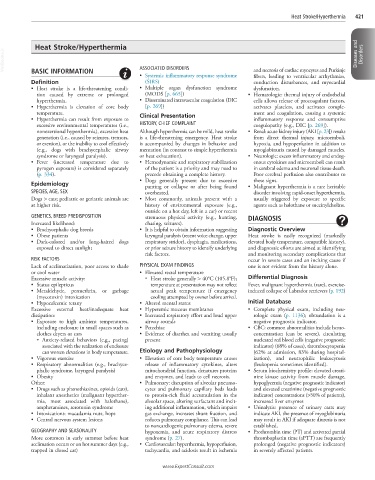Page 870 - Cote clinical veterinary advisor dogs and cats 4th
P. 870
Heat Stroke/Hyperthermia 421
Heat Stroke/Hyperthermia
VetBooks.ir ASSOCIATED DISORDERS Diseases and Disorders
BASIC INFORMATION
• Systemic inflammatory response syndrome and necrosis of cardiac myocytes and Purkinje
fibers, leading to ventricular arrhythmias,
Definition (SIRS) conduction disturbances, and myocardial
• Heat stroke is a life-threatening condi- • Multiple organ dysfunction syndrome dysfunction.
tion caused by extreme or prolonged (MODS [p. 665]) • Hematologic: thermal injury of endothelial
hyperthermia. • Disseminated intravascular coagulation (DIC cells allows release of procoagulant factors,
• Hyperthermia is elevation of core body [p. 269]) activates platelets, and activates comple-
temperature. Clinical Presentation ment and coagulation, causing a systemic
• Hyperthermia can result from exposure to inflammatory response and consumptive
excessive environmental temperatures (i.e., HISTORY, CHIEF COMPLAINT coagulopathy (e.g., DIC [p. 269]).
nonexertional hyperthermia), excessive heat Although hyperthermia can be mild, heat stroke • Renal: acute kidney injury (AKI [p. 23]) results
generation (i.e., caused by seizures, tremors, is a life-threatening emergency. Heat stroke from direct thermal injury, microemboli,
or exertion), or the inability to cool effectively is accompanied by changes in behavior and hypoxia, and hypoperfusion in addition to
(e.g., dogs with brachycephalic airway mentation (in contrast to simple hyperthermia myoglobinuria caused by damaged muscles.
syndrome or laryngeal paralysis). or heat exhaustion). • Neurologic: excess inflammatory and endog-
• Fever (increased temperature due to • Hemodynamic and respiratory stabilization enous cytokines and microemboli can result
pyrogen exposure) is considered separately of the patient is a priority and may need to in cerebral edema and neuronal tissue death.
(p. 334). precede obtaining a complete history. Poor cerebral perfusion also contributes to
• Dogs generally present due to excessive these signs.
Epidemiology panting or collapse or after being found • Malignant hyperthermia is a rare heritable
SPECIES, AGE, SEX overheated. disorder involving rapid-onset hyperthermia,
Dogs > cats; pediatric or geriatric animals are • Most commonly, animals present with a usually triggered by exposure to specific
at higher risk. history of environmental exposure (e.g., agents such as halothane or succinylcholine.
outside on a hot day, left in a car) or recent
GENETICS, BREED PREDISPOSITION strenuous physical activity (e.g., hunting, DIAGNOSIS
Increased likelihood: chasing, seizures).
• Brachycephalic dog breeds • It is helpful to obtain information suggesting Diagnostic Overview
• Obese patients laryngeal paralysis (recent voice change, upper Heat stroke is easily recognized (markedly
• Dark-colored and/or long-haired dogs respiratory stridor), dysphagia, medications, elevated body temperature, compatible history),
exposed to direct sunlight or prior seizure history to identify underlying and diagnostic efforts are aimed at identifying
risk factors. and monitoring secondary complications that
RISK FACTORS occur in severe cases and an inciting cause if
Lack of acclimatization, poor access to shade PHYSICAL EXAM FINDINGS one is not evident from the history alone.
or cool water • Elevated rectal temperature
Excessive muscle activity: ○ Heat stroke generally > 40°C (105.8°F); Differential Diagnosis
• Status epilepticus temperature at presentation may not reflect Fever, malignant hyperthermia (rare), exercise-
• Metaldehyde, permethrin, or garbage actual peak temperature if emergency induced collapse of Labrador retrievers (p. 192)
(mycotoxin) intoxication cooling attempted by owner before arrival.
• Hypocalcemic tetany • Altered mental status Initial Database
Excessive external heat/inadequate heat • Hyperemic mucous membranes • Complete physical exam, including neu-
dissipation: • Increased respiratory effort and loud upper rologic exam (p. 1136); obtundation is a
• Exposure to high ambient temperatures, airway sounds negative prognostic indicator.
including enclosure in small spaces such as • Petechiae • CBC: common abnormalities include hemo-
clothes dryers or cars • Evidence of diarrhea and vomiting usually concentration (can be severe), circulating
○ Anxiety-related behaviors (e.g., pacing) present nucleated red blood cells (negative prognostic
associated with the realization of enclosure indicator) (68% of cases), thrombocytopenia
can worsen elevations in body temperature. Etiology and Pathophysiology (62% at admission, 83% during hospital-
• Vigorous exercise • Elevation of core body temperature causes ization), and neutrophilic leukocytosis
• Respiratory abnormalities (e.g., brachyce- release of inflammatory cytokines, alters (leukopenia sometimes identified).
phalic syndrome, laryngeal paralysis) mitochondrial function, denatures proteins • Serum biochemistry profile: elevated creati-
• Obesity and enzymes, and leads to cell necrosis. nine kinase activity from muscle damage,
Other: • Pulmonary: disruption of alveolar pneumo- hypoglycemia (negative prognostic indicator)
• Drugs such as phenothiazines, opioids (cats), cytes and pulmonary capillary beds leads and elevated creatinine (negative prognostic
inhalant anesthetics (malignant hyperther- to protein-rich fluid accumulation in the indicator) concentrations (>50% of patients),
mia, most associated with halothane), alveolar space, altering surfactant and incit- increased liver enzymes
amphetamines, serotonin syndrome ing additional inflammation, which impairs • Urinalysis: presence of urinary casts may
• Intoxications: macadamia nuts, hops gas exchange, increases shunt fraction, and indicate AKI, the presence of myoglobinuria
• Central nervous system lesions reduces pulmonary compliance. This can lead may result in AKI if adequate diuresis is not
to noncardiogenic pulmonary edema, severe established.
GEOGRAPHY AND SEASONALITY hypoxemia, and acute respiratory distress • Prothrombin time (PT) and activated partial
More common in early summer before heat syndrome (p. 27). thromboplastin time (aPTT) are frequently
acclimation occurs or on hot summer days (e.g., • Cardiovascular: hyperthermia, hypoperfusion, prolonged (negative prognostic indicators)
trapped in closed car) tachycardia, and acidosis result in ischemia in severely affected patients.
www.ExpertConsult.com

